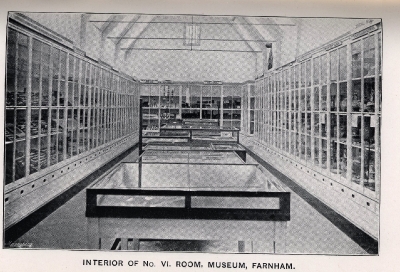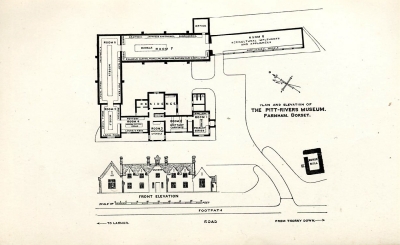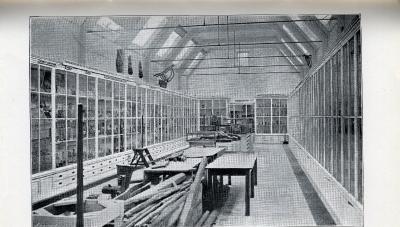To search the RPR site click here
This is a transcription of the guide to Farnham Museum written by Pitt-Rivers. There were at least two editions of the guide to the Larmer Grounds, Farnham Museum etc, written by Pitt-Rivers but unfortunately it is not certain which this is. One was published just after his death, the other at some point between 1880 and 1900. It seems most likely that this was published before 1900 as Room 9 is not mentioned and was the last room to be added [I am grateful to Rachel McGoff for pointing this out]
A short guide to the Larmer Grounds, Rushmore, King John's House; and the Museum at Farnham, Dorset
The section related to the Larmer Grounds has been omitted. The section relating to King John's House can be found here.
The Museum is within five minutes' walk of the hotel, where there is ample accommodation for horses and carriages. The Museum consists of eight rooms and galleries three of which are 85, 80 and 60 feet long respectively. The side walls are lined with glass cases containing the objects, and the galleries are lighted from above. The centre part of the four principal rooms contains models of excavations conducted by General Rivers in the neighbourhood. No. 1 room contains specimens of peasant costume and personal ornament of different nations. No. 2 room includes peasant carvings, chiefly from Brittany, which were for some time exhibited by General Rivers at South Kensington and Bethnal Green. No. 3 room is devoted to household utensils used by peasants in different countries. In No. 4 room commences a series of ancient and mediaeval pottery of all nations and countries, which continues through rooms Nos. 5 & 6, and is divided under the following heads, viz., Ancient British, Silesian Bronze Age, Etruscan, Swiss Lakes, Cyprian of all ages from Phoenician to Roman, Ancient Greek, Roman, Saxon, and Norman; Mediaeval British, Old English, Scotch, Dutch, German, French and Italian, Spanish, Persian, Rhodian, Anatolian, Chinese, Japanese, Egyptian, Moorish, Cingalese, Indian, Mexican, and Peruvian. The eye, in glancing from one division to another, is able to contrast the various styles prevailing in different periods and countries. Room No. 4 also contains, in the centre, modern brown pottery resembling the ancient, from the West Indies and Hindostan, and a series illustrating the history of primitive locks, keys, and padlocks, showing their gradual development, with a descriptive account of them. No. 5 room contains models of the Romano-British village of Woodcuts, two miles from the Museum, with the relics from the excavations arranged in the cases around; portions of this village are shown in models on a larger scale. This room also contains other antiquities from the neighbourhood.  No. 6 room contains models of the Romano-British village of Rotherley, three miles from the Museum, with the relics from it, and models on a larger scale of portions of the village; also models of the excavations made by General Rivers in the Romano-British settlement at Woodyates, about six miles on the road to Salisbury excavated in 1888-90; models of excavations in Bokerly Dyke, and Wansdyke near Devizes. A series in the side cases illustrates briefly the history of stone and bronze implements, and includes the Palaeolithic period, Neolithic period, Bronze age, Iron, Roman, Saxon, and Merovingian periods. The 7th room contains a series illustrating the history of glass making from the earliest times, including three stages of Egyptian glass (presented by Mr. Petrie), specimens of Phoenician, Greek, Roman, Saxon, Chinese, early and modern Venetian, French, German, and English glass. A series explaining the history of enamelling, including early Egyptian, Roman, Celtic, Saxon, and Volkerwanderung periods; specimens of encaustic tiles, the forerunners of Champlevée, Cloisonné, surface, and translucent enamels, and enamelled pictures and ornaments from China, Japan, Persia, France, Germany, England, Russia, and Algeria, mediaeval and modern. Specimens are also exhibited showing the transition from stone and glass inlaying in ornamentation, to cloisonné enamelling. On the other side of the room are models showing the development of the form of the Christian Cross in Celtic times. The remainder of the side cases are devoted to a series of carvings of different countries, showing the characteristic forms of art prevailing at the various times and places, and including carvings from Australia, New Zealand, New Guinea, North and South America, South Africa, India, Burmah, Japan, ancient Egypt, Assyria, Greek, Roman, Cyprian, Etruscan, early Christian, mediaeval, European, Scandinavian, and a series exemplifying the arts of modern times. In the cases on the opposite side are represented drawings and paintings on the flat from different countries, including ancient Egyptian, Phoenician, Cyprian, Japanese, Etruscan, and Greek drawings; also a series of the drawings of savages, and one for comparison, showing the best performances of untaught children and adults from the neighbourhood. This case contains also a series of embroideries, and a collection of lamps and lighting apparatus from different countries. In the centre of this room are models of tumuli excavated by General Rivers in the neighbourhood, and elsewhere, including some explorations conducted by him in the valley of the Nile. The relics are arranged in cases round the models. The 8th room is devoted to agricultural implements and appliances, and includes a series of querns, a model of an Indian village, models of crofter's houses and sheelings in Scotland, foreign winnowing and other agricultural machines, a series of models of ploughs of different countries, and of country carts, scythes, reaping hooks, spades and textile fabrics from different localities.
No. 6 room contains models of the Romano-British village of Rotherley, three miles from the Museum, with the relics from it, and models on a larger scale of portions of the village; also models of the excavations made by General Rivers in the Romano-British settlement at Woodyates, about six miles on the road to Salisbury excavated in 1888-90; models of excavations in Bokerly Dyke, and Wansdyke near Devizes. A series in the side cases illustrates briefly the history of stone and bronze implements, and includes the Palaeolithic period, Neolithic period, Bronze age, Iron, Roman, Saxon, and Merovingian periods. The 7th room contains a series illustrating the history of glass making from the earliest times, including three stages of Egyptian glass (presented by Mr. Petrie), specimens of Phoenician, Greek, Roman, Saxon, Chinese, early and modern Venetian, French, German, and English glass. A series explaining the history of enamelling, including early Egyptian, Roman, Celtic, Saxon, and Volkerwanderung periods; specimens of encaustic tiles, the forerunners of Champlevée, Cloisonné, surface, and translucent enamels, and enamelled pictures and ornaments from China, Japan, Persia, France, Germany, England, Russia, and Algeria, mediaeval and modern. Specimens are also exhibited showing the transition from stone and glass inlaying in ornamentation, to cloisonné enamelling. On the other side of the room are models showing the development of the form of the Christian Cross in Celtic times. The remainder of the side cases are devoted to a series of carvings of different countries, showing the characteristic forms of art prevailing at the various times and places, and including carvings from Australia, New Zealand, New Guinea, North and South America, South Africa, India, Burmah, Japan, ancient Egypt, Assyria, Greek, Roman, Cyprian, Etruscan, early Christian, mediaeval, European, Scandinavian, and a series exemplifying the arts of modern times. In the cases on the opposite side are represented drawings and paintings on the flat from different countries, including ancient Egyptian, Phoenician, Cyprian, Japanese, Etruscan, and Greek drawings; also a series of the drawings of savages, and one for comparison, showing the best performances of untaught children and adults from the neighbourhood. This case contains also a series of embroideries, and a collection of lamps and lighting apparatus from different countries. In the centre of this room are models of tumuli excavated by General Rivers in the neighbourhood, and elsewhere, including some explorations conducted by him in the valley of the Nile. The relics are arranged in cases round the models. The 8th room is devoted to agricultural implements and appliances, and includes a series of querns, a model of an Indian village, models of crofter's houses and sheelings in Scotland, foreign winnowing and other agricultural machines, a series of models of ploughs of different countries, and of country carts, scythes, reaping hooks, spades and textile fabrics from different localities.
Every object in the Museum has a large ticket attached to it, and descriptive accounts are added in various places, so that no catalogue is needed. The divisions of subjects are marked by thin red satin tapes hanging across the shelves from the top, and the larger divisions are marked by broader red satin bands with the word "Division" embroidered on it. The three 4to. volumes of Excavations by General Rivers, with copious illustrations, are placed on desks in the galleries for the convenience of those who wish to study these several subjects in greater detail than is afforded by the printed headings on the models.
The Museum contains 200 yards of wall cases, besides the cases in the centre of the rooms. Outside the Museum is a Norse Mill, obtained from the Island of Lewis, on the coast of Scotland, representing the earliest form of water-mill, still used occasionally in parts of Scotland.
The Museum is open every day, Sundays included, and is in charge of a caretaker.
Transcribed by AP for the Rethinking Pitt-Rivers project 2010





